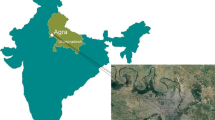Abstract
Nitrate is one of the common contaminants in the present day groundwaters resulting from increased population associated with poor sanitary conditions in the habitat area and increased agricultural activity. The hydrochemical measurements on water samples from a virgin watershed, situated in the basaltic geo-environment, have become necessary as the groundwater is the only source of drinking water for the villagers of the area. High preferential recharge conditions prevail in the area due to fractures in the solid basaltic lava flows. Instead of dilution due to fresh recharge, the post-monsoon hydrochemical concentrations in the groundwater are observed to have increased probably due to fast migration of pollutants to the aquifer through preferential recharge. As a result, the deep aquifer waters are more contaminated with hazardous nitrate than the shallow waters. Further, the village environ wells are more polluted with nitrate than the agriculture areas which could be attributed to the unhygienic sanitary conditions and livestock waste dump pits in the villages. This study suggests proper management of the sewage system and creation of suitable dump yard for the livestock and household waste to minimize the level of nitrate pollution in the well waters of village environs.
Similar content being viewed by others
Explore related subjects
Discover the latest articles and news from researchers in related subjects, suggested using machine learning.References
Cepuder, P., & Shukla, M. K. (2002). Groundwater nitrate in Austria: A case study in Tullnerfeld. Nutrient Cycling in Agroecosystems, 64, 301–315.
Debernardi, L., De Luca, D. A., & Lasagna, M. (2008). Correlation between nitrate concentration in groundwater and parameters affecting aquifer intrinsic vulnerability. Environmental Geology, 55, 539–558.
Forman, D., Al-Dabbagh, S., & Doll, R. (1985). Nitrates, nitrites and gastric cancer in Great Britain. Nature, 313, 620–625.
Gupta, A. D., & Amaraweera, H. B. M. P. (1993). Assessment of long-term withdrawal rate for a coastal aquifer. Ground Water, 31(2), 260–270.
Hem, J. D. (1985). Study and interpretation of the chemical characteristics of natural water (p. 263). Water Supply Paper—2254, U.S. Geological Survey.
Jacks, G., & Sharma, V. P. (1983). Nitrogen circulation and nitrate in ground water in an agricultural catchment in Southern India. Environmental Geochemistry, 5(2), 61–64.
Karanth, K. R. (1996). Hydrogeology (p. 458). New Delhi: Tata McGraw-Hill.
Komar, S. C., & Anderson, H. W. (1993). Nitrogen isotopes as indicators if nitrate source in Minnesota sand plain aquifers. Groundwater, 31(2), 250–270.
Krupanidhi, K. V. J. R. (1984). Mechanism of groundwater pollution in village wells. Journal of the Geological Society of India, 25(5), 301–302.
Naik, P. K., Tambe, J. A., Dehury, B. N., & Tiwari, A. N. (2008). Impact of urbanization on the groundwater regime in a fast growing city in central India. Environmental Monitoring and Assessment, 146, 339–373.
Pawar, N. J., & Shaikh, I. J. (1995). Nitrate pollution of groundwaters from shallow basaltic aquifers, Deccan Trap hydrologic province, India. Environmental Geology, 25, 197–204.
Payne, M. R. (1993). Farm waste and nitrate pollution. In J. G. Jones (Ed.), Agriculture and the environment (pp. 63–73). New York: Horwood.
Poinke, H. B., & Urban, J. B. (1985). Effect of agricultural land-use on groundwater quality in a small Pennsylvania watershed. Ground Water, 23, 68–80.
Reddy, A. G. S., Kumar, K. N., Rao, D. S., & Rao, S. S. (2009). Assessment of nitrate contamination due to groundwater pollution in north eastern part of Anantapur District, A.P. India. Environmental Monitoring and Assessment, 148, 463–476.
Stigter, T. Y., van Ooijen, S. P. J., Post, V. E. A., Appelo, C. A. J., & Carvalho Dill, A. M. M. (1998). A hydrogeological and hydrochemical explanation of the groundwater composition under irrigated land in a Mediterranean environment, Algarve, Portugal. Journal of Hydrology, 208, 262–279.
Tayfur, G., Kirer, T., & Baba, A. (2008). Groundwater quality and hydrogeochemical properties of Torbali region, Izmir, Turkey. Environmental Monitoring and Assessment, 146, 157–169.
Thayalakumaran, T., Bristow, K. L., Charlesworth, P. B., & Fass, T. (2008). Geochemical conditions in groundwater systems: Implications for the attenuation of agricultural nitrate. Agricultural Water Management, 95, 103–115.
Vidal, M., Melgar, J., Opez, A. L., & Santoalla, M. C. (2000). Spatial and temporal hydrochemical changes in groundwater under the contaminating effects of fertilizers and wastewater. Journal of Environmental Management, 60, 215–225.
Wakida, F. T., & Lerner, D. N. (2005). Non-agricultural sources of groundwater nitrate: A review and case study. Water Research, 39, 3–16.
Walker, W. H. (1973). Ground water nitrate pollution in rural areas. Ground water, 11(5), 19–22.
WHO (2008). Guidelines for drinking-water quality—Incorporating first addendum to Third Edition. Recommendations (Vol. 1, p. 595). Geneva. http://www.who.int/water_sanitation_health/dwq/GDWPRecomdrev1and2.pdf.
Williams, A. E., Lund, L. J., Johnson, J. A., & Kabala, Z. J. (1998). Natural and anthropogenic nitrate contamination of groundwater in a rural community, California. Environmental Science and Technology, 32(1), 32–39.
Author information
Authors and Affiliations
Corresponding author
Rights and permissions
About this article
Cite this article
Reddy, D.V., Nagabhushanam, P. & Peters, E. Village environs as source of nitrate contamination in groundwater: a case study in basaltic geo-environment in central India. Environ Monit Assess 174, 481–492 (2011). https://doi.org/10.1007/s10661-010-1472-x
Received:
Accepted:
Published:
Issue Date:
DOI: https://doi.org/10.1007/s10661-010-1472-x




